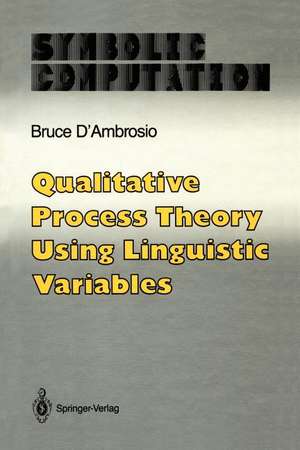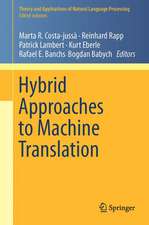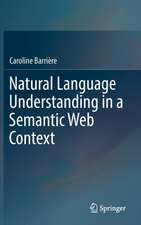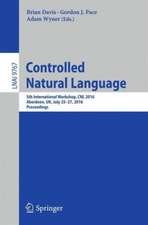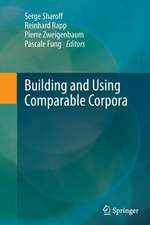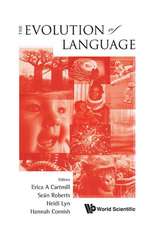Qualitative Process Theory Using Linguistic Variables: Symbolic Computation
Autor Bruce D'Ambrosioen Limba Engleză Paperback – 19 ian 2012
Din seria Symbolic Computation
- 20%
 Preț: 350.21 lei
Preț: 350.21 lei - 20%
 Preț: 651.89 lei
Preț: 651.89 lei - 20%
 Preț: 647.61 lei
Preț: 647.61 lei - 20%
 Preț: 649.09 lei
Preț: 649.09 lei - 20%
 Preț: 648.44 lei
Preț: 648.44 lei - 20%
 Preț: 653.06 lei
Preț: 653.06 lei - 20%
 Preț: 642.19 lei
Preț: 642.19 lei - 20%
 Preț: 651.09 lei
Preț: 651.09 lei - 20%
 Preț: 659.97 lei
Preț: 659.97 lei - 20%
 Preț: 645.31 lei
Preț: 645.31 lei - 20%
 Preț: 648.44 lei
Preț: 648.44 lei - 20%
 Preț: 650.27 lei
Preț: 650.27 lei - 20%
 Preț: 646.47 lei
Preț: 646.47 lei -
 Preț: 394.29 lei
Preț: 394.29 lei - 20%
 Preț: 326.46 lei
Preț: 326.46 lei - 20%
 Preț: 342.28 lei
Preț: 342.28 lei - 20%
 Preț: 339.99 lei
Preț: 339.99 lei - 20%
 Preț: 641.01 lei
Preț: 641.01 lei - 20%
 Preț: 657.99 lei
Preț: 657.99 lei - 20%
 Preț: 648.26 lei
Preț: 648.26 lei - 20%
 Preț: 661.47 lei
Preț: 661.47 lei - 15%
 Preț: 638.89 lei
Preț: 638.89 lei - 20%
 Preț: 657.67 lei
Preț: 657.67 lei - 20%
 Preț: 652.73 lei
Preț: 652.73 lei - 20%
 Preț: 330.42 lei
Preț: 330.42 lei - 20%
 Preț: 709.98 lei
Preț: 709.98 lei - 20%
 Preț: 834.69 lei
Preț: 834.69 lei - 20%
 Preț: 656.03 lei
Preț: 656.03 lei - 20%
 Preț: 324.64 lei
Preț: 324.64 lei - 20%
 Preț: 757.48 lei
Preț: 757.48 lei - 20%
 Preț: 355.67 lei
Preț: 355.67 lei - 20%
 Preț: 328.27 lei
Preț: 328.27 lei - 20%
 Preț: 330.24 lei
Preț: 330.24 lei - 20%
 Preț: 342.96 lei
Preț: 342.96 lei - 20%
 Preț: 555.53 lei
Preț: 555.53 lei
Preț: 639.35 lei
Preț vechi: 799.19 lei
-20% Nou
Puncte Express: 959
Preț estimativ în valută:
122.36€ • 127.27$ • 101.01£
122.36€ • 127.27$ • 101.01£
Carte tipărită la comandă
Livrare economică 14-28 aprilie
Preluare comenzi: 021 569.72.76
Specificații
ISBN-13: 9781461396734
ISBN-10: 1461396735
Pagini: 172
Ilustrații: X, 156 p. 1 illus.
Dimensiuni: 155 x 235 x 9 mm
Greutate: 0.25 kg
Ediția:Softcover reprint of the original 1st ed. 1989
Editura: Springer
Colecția Springer
Seriile Symbolic Computation, Artificial Intelligence
Locul publicării:New York, NY, United States
ISBN-10: 1461396735
Pagini: 172
Ilustrații: X, 156 p. 1 illus.
Dimensiuni: 155 x 235 x 9 mm
Greutate: 0.25 kg
Ediția:Softcover reprint of the original 1st ed. 1989
Editura: Springer
Colecția Springer
Seriile Symbolic Computation, Artificial Intelligence
Locul publicării:New York, NY, United States
Public țintă
ResearchCuprins
1 Overview.- 2 Fuzzy Logic Control.- 2.1 Classical Control Theory.- 2.2 A New Approach to Control of Complex Systems.- 2.3 Fuzzy Control.- 2.4 Extensions of the Fuzzy Control Paradigm.- 2.5 The Next Step: Fuzzy-Model-Based Control.- 3 Introduction to Qualitative Process Theory.- 3.1 Uses of QP Theory.- 3.2 Process versus Device-Centered Theories.- 3.3 Qualitative Process Theory - Definitions and Examples.- 3.4 Reasoning in QP Theory.- 3.5 Historical Background.- 3.6 Summary.- 4 Application of QP Theory to Process Control - An Example.- 4.1 The Reaction Process.- 4.2 Countercurrent Heat Flow.- 4.3 Basic Deductions.- 5 Ambiguity in QP Theory.- 5.1 Ambiguity in QP Theory.- 5.2 Representation Alternatives.- 5.3 Related Work.- 5.4 Linguistic Extensions to QP Descriptions.- 6 Linguistic Variables.- 6.1 Introduction to Linguistic Variables.- 6.2 Approximate Reasoning and the Compositional Rule of Inference.- 6.3 Similarity of Linguistic Variables and Relations.- 6.4 Support-Pair Certainty.- 6.5 Truth Maintenance with Numeric Certainty Estimates.- 6.6 Summary.- 7 Linguistic Quantity Spaces.- 7.1 A Functional Overview.- 7.2 Computing the Consequences of a Linguistic Quantity Space.- 7.3 Linguistic Measurement Interpretation.- 8 Characterization of Functional Relationships.- 8.1 Sources of Ambiguity in QP Theory Models.- 8.2 Fuzzy Relational Algorithms.- 8.3 Annotation Management.- 8.4 Examples.- 8.5 Summary.- 9 Qualitative Perturbation Analysis.- 9.1 Qualitative Perturbation Analysis.- 9.2 Extended Perturbation Analysis.- 9.3 Linguistic Perturbation Analysis.- 9.4 LPA Extended Example.- 9.5 Summary.- 10 Evaluation and Conclusion.- 10.1 Review.- 10.2 Evaluation.- 10.3 Further Research.- 10.4 Conclusion.- 10.5 References.
